The NVIDIA GeForce RTX 2080 Ti & RTX 2080 Founders Edition Review: Foundations For A Ray Traced Future
by Nate Oh on September 19, 2018 5:15 PM EST- Posted in
- GPUs
- Raytrace
- GeForce
- NVIDIA
- DirectX Raytracing
- Turing
- GeForce RTX
The RTX Recap: A Brief Overview of the Turing RTX Platform
Overall, NVIDIA’s grand vision for real-time, hybridized raytracing graphics means that they needed to make significant architectural investments into future GPUs. The very nature of the operations required for ray tracing means that they don’t map to traditional SIMT execution especially well, and while this doesn’t preclude GPU raytracing via traditional GPU compute, it does end up doing so relatively inefficiently. Which means that of the many architectural changes in Turing, a lot of them have gone into solving the raytracing problem – some of which exclusively so.
To that end, on the ray tracing front Turing introduces two new kinds of hardware units that were not present on its Pascal predecessor: RT cores and Tensor cores. The former is pretty much exactly what the name says on the tin, with RT cores accelerating the process of tracing rays, and all the new algorithms involved in that. Meanwhile the tensor cores are technically not related to the raytracing process itself, however they play a key part in making raytracing rendering viable, along with powering some other features being rolled out with the GeForce RTX series.
Starting with the RT cores, these are perhaps NVIDIA’s biggest innovation – efficient raytracing is a legitimately hard problem – however for that reason they’re also the piece of the puzzle that NVIDIA likes talking about the least. The company isn’t being entirely mum, thankfully. But we really only have a high level overview of what they do, with the secret sauce being very much secret. How NVIDIA ever solved the coherence problems that dog normal raytracing methods, they aren’t saying.
At a high level then, the RT cores can essentially be considered a fixed-function block that is designed specifically to accelerate Bounding Volume Hierarchy (BVH) searches. BVH is a tree-like structure used to store polygon information for raytracing, and it’s used here because it’s an innately efficient means of testing ray intersection. Specifically, by continuously subdividing a scene through ever-smaller bounding boxes, it becomes possible to identify the polygon(s) a ray intersects with in only a fraction of the time it would take to otherwise test all polygons.
NVIDIA’s RT cores then implement a hyper-optimized version of this process. What precisely that entails is NVIDIA’s secret sauce – in particular the how NVIDIA came to determine the best BVH variation for hardware acceleration – but in the end the RT cores are designed very specifically to accelerate this process. The end product is a collection of two distinct hardware blocks that constantly iterate through bounding box or polygon checks respectively to test intersection, to the tune of billions of rays per second and many times that number in individual tests. All told, NVIDIA claims that the fastest Turing parts, based on the TU102 GPU, can handle upwards of 10 billion ray intersections per second (10 GigaRays/second), ten-times what Pascal can do if it follows the same process using its shaders.
NVIDIA has not disclosed the size of an individual RT core, but they’re thought to be rather large. Turing implements just one RT core per SM, which means that even the massive TU102 GPU in the RTX 2080 Ti only has 72 of the units. Furthermore because the RT cores are part of the SM, they’re tightly couple to the SMs in terms of both performance and core counts. As NVIDIA scales down Turing for smaller GPUs by using a smaller number of SMs, the number of RT cores and resulting raytracing performance scale down with it as well. So NVIDIA always maintains the same ratio of SM resources (though chip designs can very elsewhere).
Along with developing a means to more efficiently test ray intersections, the other part of the formula for raytracing success in NVIDIA’s book is to eliminate as much of that work as possible. NVIDIA’s RT cores are comparatively fast, but even so, ray interaction testing is still moderately expensive. As a result, NVIDIA has turned to their tensor cores to carry them the rest of the way, allowing a moderate number of rays to still be sufficient for high-quality images.
In a nutshell, raytracing normally requires casting many rays from each and every pixel in a screen. This is necessary because it takes a large number of rays per pixel to generate the “clean” look of a fully rendered image. Conversely if you test too few rays, you end up with a “noisy” image where there’s significant discontinuity between pixels because there haven’t been enough rays casted to resolve the finer details. But since NVIDIA can’t actually test that many rays in real time, they’re doing the next-best thing and faking it, using neural networks to clean up an image and make it look more detailed than it actually is (or at least, started out at).
To do this, NVIDIA is tapping their tensor cores. These cores were first introduced in NVIDIA’s server-only Volta architecture, and can be thought of as a CUDA core on steroids. Fundamentally they’re just a much larger collection of ALUs inside a single core, with much of their flexibility stripped away. So instead of getting the highly flexible CUDA core, you end up with a massive matrix multiplication machine that is incredibly optimized for processing thousands of values at once (in what’s called a tensor operation). Turing’s tensor cores, in turn, double down on what Volta started by supporting newer, lower precision methods than the original that in certain cases can deliver even better performance while still offering sufficient accuracy.
As for how this applies to ray tracing, the strength of tensor cores is that tensor operations map extremely well to neural network inferencing. This means that NVIDIA can use the cores to run neural networks which will perform additional rendering tasks. in this case a neural network denoising filter is used to clean up the noisy raytraced image in a fraction of the time (and with a fraction of the resources) it would take to actually test the necessary number of rays.
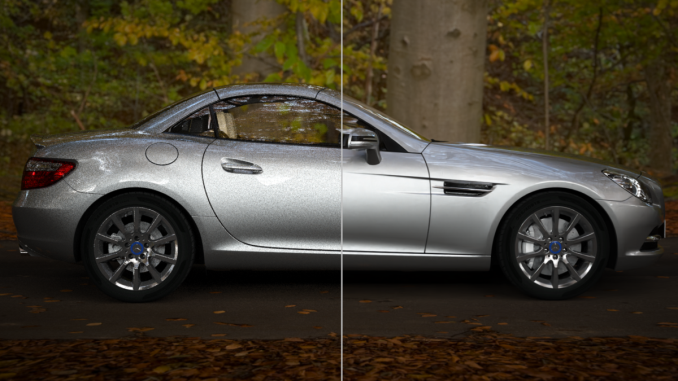
No Denoising vs. Denoising in Raytracing
The denoising filter itself is essentially an image resizing filter on steroids, and can (usually) produce a similar quality image as brute force ray tracing by algorithmically guessing what details should be present among the noise. However getting it to perform well means that it needs to be trained, and thus it’s not a generic solution. Rather developers need to take part in the process, training a neural network based on high quality fully rendered images from their game.
Overall there are 8 tensor cores in every SM, so like the RT cores, they are tightly coupled with NVIDIA’s individual processor blocks. Furthermore this means tensor performance scales down with smaller GPUs (smaller SM counts) very well. So NVIDIA always has the same ratio of tensor cores to RT cores to handle what the RT cores coarsely spit out.
Deep Learning Super Sampling (DLSS)
Now with all of that said, unlike the RT cores, the tensor cores are not fixed function hardware in a traditional sense. They’re quite rigid in their abilities, but they are programmable none the less. And for their part, NVIDIA wants to see just how many different fields/tasks that they can apply their extensive neural network and AI hardware to.
Games of course don’t fall under the umbrella of traditional neural network tasks, as these networks lean towards consuming and analyzing images rather than creating them. None the less, along with denoising the output of their RT cores, NVIDIA’s other big gaming use case for their tensor cores is what they’re calling Deep Learning Super Sampling (DLSS).
DLSS follows the same principle as denoising – how can post-processing be used to clean up an image – but rather than removing noise, it’s about restoring detail. Specifically, how to approximate the image quality benefits of anti-aliasing – itself a roundabout way of rendering at a higher resolution – without the high cost of actually doing the work. When all goes right, according to NVIDIA the result is an image comparable to an anti-aliased image without the high cost.
Under the hood, the way this works is up to the developers, in part because they’re deciding how much work they want to do with regular rendering versus DLSS upscaling. In the standard mode, DLSS renders at a lower input sample count – typically 2x less but may depend on the game – and then infers a result, which at target resolution is similar quality to a Temporal Anti-Aliasing (TAA) result. A DLSS 2X mode exists, where the input is rendered at the final target resolution and then combined with a larger DLSS network. TAA is arguably not a very high bar to set – it’s also a hack of sorts that seeks to avoid doing real overdrawing in favor of post-processing – however NVIDIA is setting out to resolve some of TAA’s traditional inadequacies with DLSS, particularly blurring.
Now it should be noted that DLSS has to be trained per-game; it isn’t a one-size-fits all solution. This is done in order to apply a unique neutral network that’s appropriate for the game at-hand. In this case the neural networks are trained using 64x SSAA images, giving the networks a very high quality baseline to work against.
None the less, of NVIDIA’s two major gaming use cases for the tensor cores, DLSS is by far the more easily implemented. Developers need only to do some basic work to add NVIDIA’s NGX API calls to a game – essentially adding DLSS as a post-processing stage – and NVIDIA will do the rest as far as neural network training is concerned. So DLSS support will be coming out of the gate very quickly, while raytracing (and especially meaningful raytracing) utilization will take much longer.
In sum, then the upcoming game support aligns with the following table.
| Planned NVIDIA Turing Feature Support for Games | |||||
| Game | Real Time Raytracing | Deep Learning Supersampling (DLSS) | Turing Advanced Shading | ||
| Ark: Survival Evolved | Yes | ||||
| Assetto Corsa Competizione | Yes | ||||
| Atomic Heart | Yes | Yes | |||
| Battlefield V | Yes | ||||
| Control | Yes | ||||
| Dauntless | Yes | ||||
| Darksiders III | Yes | ||||
| Deliver Us The Moon: Fortuna | Yes | ||||
| Enlisted | Yes | ||||
| Fear The Wolves | Yes | ||||
| Final Fantasy XV | Yes | ||||
| Fractured Lands | Yes | ||||
| Hellblade: Senua's Sacrifice | Yes | ||||
| Hitman 2 | Yes | ||||
| In Death | Yes | ||||
| Islands of Nyne | Yes | ||||
| Justice | Yes | Yes | |||
| JX3 | Yes | Yes | |||
| KINETIK | Yes | ||||
| MechWarrior 5: Mercenaries | Yes | Yes | |||
| Metro Exodus | Yes | ||||
| Outpost Zero | Yes | ||||
| Overkill's The Walking Dead | Yes | ||||
| PlayerUnknown Battlegrounds | Yes | ||||
| ProjectDH | Yes | ||||
| Remnant: From the Ashes | Yes | ||||
| SCUM | Yes | ||||
| Serious Sam 4: Planet Badass | Yes | ||||
| Shadow of the Tomb Raider | Yes | ||||
| Stormdivers | Yes | ||||
| The Forge Arena | Yes | ||||
| We Happy Few | Yes | ||||
| Wolfenstein II | Yes | ||||


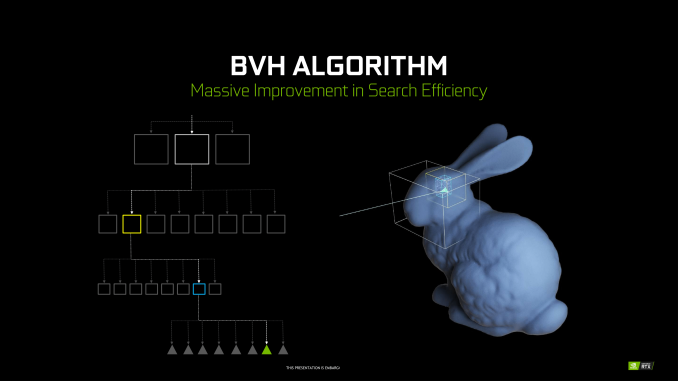
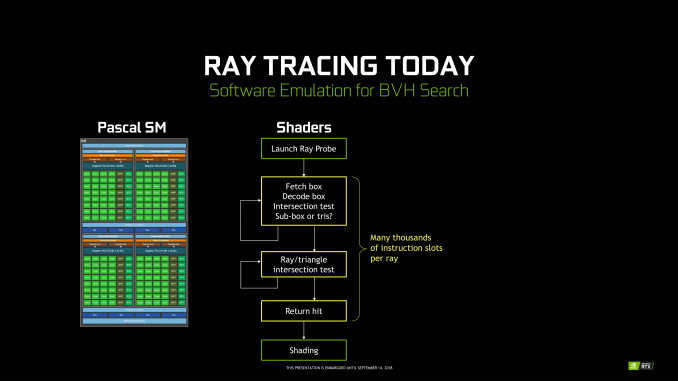
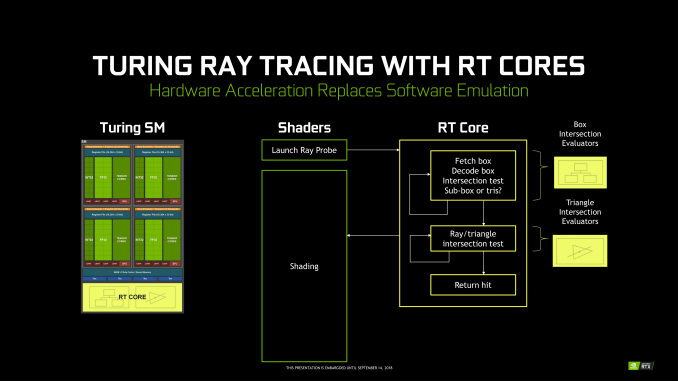
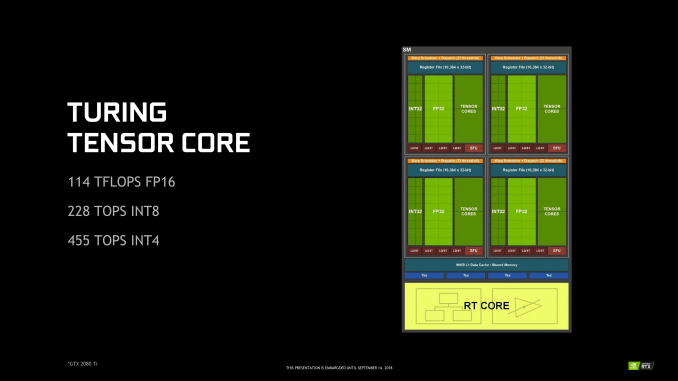
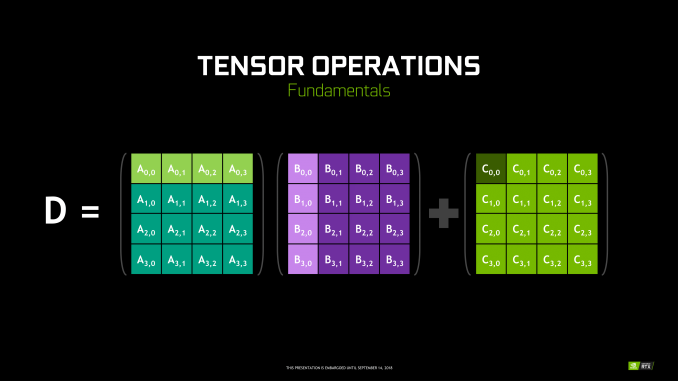
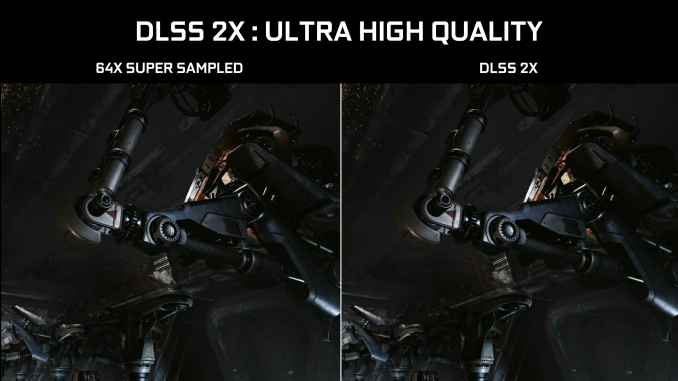








337 Comments
View All Comments
Santoval - Wednesday, September 19, 2018 - link
The problem is that it does not bring those things to the current table but is going to bring them to a future table. Essentially they expect you to buy a graphics cards that no current game can support its advanced features merely on faith that it both will deliver them in the future *and* that they will be will be worth the very high premium.If there is one ultimate unwritten rule when buying computers, computer parts or anything really, it must be this one : Never buy anything based on promises of *future* capabilities - always make your purchasing decisions based on what the products you buy can deliver *now*. All experienced computer and console consumers, in particular, must have that maxim engraved on their brain after having been burnt by so many broken promises.
Writer's Block - Monday, October 1, 2018 - link
That is certainly true; 'we promise', politicians and companies selling their shit use it a lot... And break it about as often.Inteli - Wednesday, September 19, 2018 - link
It's not that the price increase wasn't warranted, at least from the transistor count perspective, it's that there's not a lot to show for it.Many more transistors...concentrated in Tensor cores and RTX cores, which aren't being touched in current games. The increased price is for a load of baggage that will take at least a year to really get used (and before you say it, 3 games is not "really getting used"). We're used to new GPUs performing better in current games for the same price, not performing the same in current games for the same price (and I'm absolutely discounting everything before 2008 because that was 10 years ago and the expectations of what a new μArch should bring have changed).
I get the whole "future of gaming" angle you're pushing, and it's a perfectly valid reason to buy these new GPUs, but don't act like an apples-to-apples comparison of performance *right now* is the "wrong way of looking at it". How the card performs right now is an important metric for a lot of people, and will influence their decision. Especially when we're talking a potential price difference of $100+ (with sales on 1080 Ti's, and FE 2080 prices). Obviously there isn't a valid comparison for the 2080 Ti, but anyone who can drop $1300 on a GPU probably doesn't care too much about the price tag.
Flunk - Thursday, September 20, 2018 - link
Nvidia is charging what they are because they have no competition at the top end. That's it, nothing else. They're taking in the cash today in preparation for having to price more competitively later.just4U - Thursday, September 20, 2018 - link
Flunk, we are talking Nvidia here.. typically speaking they don't lower prices to compete.. Sometimes they bump to high and to few bite.. but that's about it. The last time they lowered prices to compete was the 400 series but they'd just come off getting zonked by amd for basically 2 generations.. and when they went to the 500s series it was fairly competitive with amd.. (initially they were better but Amd continued to improve their 5000/6000 series.. til it was consistently beating Nvidia.. did they lower prices? NO.. not one bit..)TNT cards were competitive and cheap.. but once Nvidia knocked off all other contenders (aside from AMD) and started in with their geforce line they have always carried premiums regardless competition or not.
eddman - Thursday, September 20, 2018 - link
GTX 280, launched at $650 because they thought AMD couldn't do much. AMD came up with 4870. What happened? Nvidia cut the card's price to $500 a mere month after launch. So yes, they do cut prices to compete.Dragonstongue - Thursday, September 20, 2018 - link
13.6 and 18.6 (bln transistor estimated) die size of 454/754mm2 (2080/2080Ti) 12nm7.2 and 12 (bln transistor estimated) die size of 314/471 (1070/1080-1080Ti/TitanX) 16nm
yes it is "expensive" no doubt about that, but, it is Nv we are talking about, there is a reason they are way over valued as they are, they produce as cheaply as possible and rack them up in price as much as they can even when their actual cards shipped are no where near the $$$ figure they report as it should.
also, if anything else, they always have and always will BS the numbers to make themselves ALWAYS appear "supreme" no matter if it is actual power used, TDP, API features, or transistor count etc etc etc.
as far as the ray tracing crap...if they used an open source style so that everyone can use the exact same ray tracing engine so they can be directly compared to see how good they are or not then it might be "worthy" but, it is Nv they are and continue to be "it has to be our way or you don't play" type approach...I remember way back when with PhysX (which Nv boug out Ageia to do it) when Radeons were able to use it (before Nv took the ability away) they ran circles around comparable Nv cards AND used less cpu and power to do it.
Nv does not want to get "caught" in their BS, so they find nefarious ways around everything, and when you have a massive amount of $$$$$$$$$$$$$$$$ floating everything you do, it is not hard for them to "buy silence" Intel has done so time and time again, Nv does so time and time again........blekk
DLSS or whatever the fk they want to call it, means jack shit when only specific cards will be able to use it instead of being a truly open source initiative where everyone/everything gets to show how good they are (or not) and also stand to gain benefit from others putting effort into making it as good as it possibly can be...there is a reason why Nv barely supports Vulkan, because they are not "in control" it is way too easy to "prove them wrong"..funny because Vulkan has ray tracing "built in"
IMO if they are as good as they claim they are, they would do everything in the light to show they are "the best" not find ways to "hide" what they are doing.....their days are numbered....hell their stock price just took a hit....good IMHO because they should not be over $200 anyways, $100, maybe, but they absolutely should not be valued above others whos financials and product shipment as magnitudes larger.
Spunjji - Friday, September 21, 2018 - link
Remind me why consumers should give a rats-ass about die size, other than its visible effects of price and performance.If you want to sell me a substantially larger, more expensive chip that performs a little better for a lot more money, a better reason is needed than "maybe it will make some games that aren't out yet really cool in a way that we refuse to give you any performance indications about".
Screw that.
Writer's Block - Monday, October 1, 2018 - link
They look poor value; good performance, sure. But a 1080ti offers the same for much less.They want me to buy promises! Seriously, promises are never worth the paper they are printed on - digital or the real stuff.
Writer's Block - Monday, October 1, 2018 - link
Oh and, yeh agree.